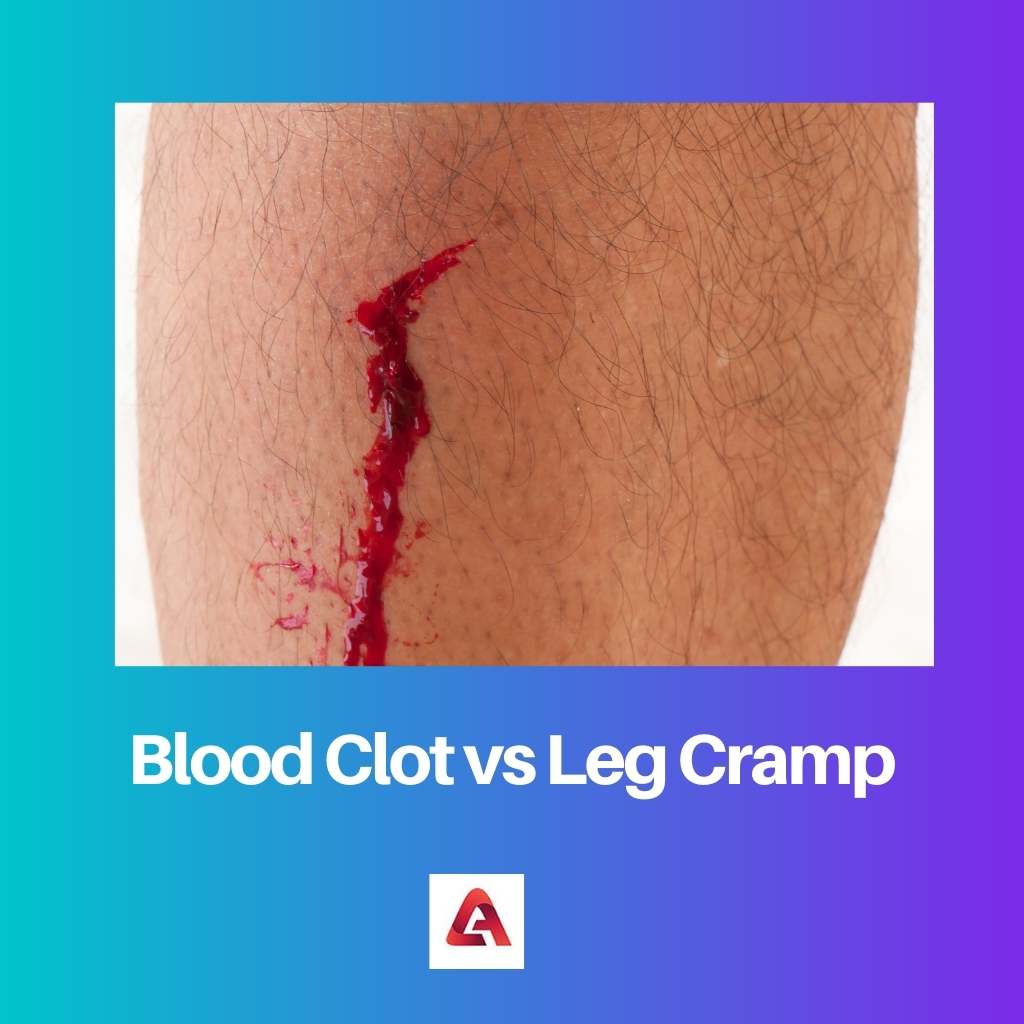A leg cramp is annoying but can be due to several medical issues. Generally, stress, wrong shoes, minor injuries, keeping legs in a bad position for a long time, or dehydration can cause leg cramps.
But if the leg cramp stays for a long time and gets worse, it can be blood clots in the legs. It occurs in the blood vessels present in the legs.
Key Takeaways
- Blood clots are a clump of blood cells that form in response to an injury or as a result of a medical condition, while leg cramps are sudden, involuntary muscle contractions.
- Blood clots can be life-threatening and require immediate medical attention, whereas leg cramps are harmless and resolve independently.
- Blood clot symptoms include swelling, redness, and warmth, while leg cramps are characterized by sudden pain and tightness in the affected muscle.
Blood Clot vs Leg Cramp
Blood clots are a mass of blood that has clotted due to injury or disease that can be life-threatening if they break loose and require medical attention. Leg cramps are a sudden and painful contraction of one or more muscles in the leg and can be relieved by stretching and massage.

A blood clot is a vital function of our body. It is a blood clump that changes from a liquid to a semisolid or gel-like state. Blood clots are a vital process that can stop blood flow whenever your skin has a cut.
When a blood clot forms inside the veins, it doesn’t dissolve on its own. This can be a life-threatening health issue and needs to be treated properly.
A leg cramp is a pain in the muscles of the legs. It can be very excruciating. Leg cramps are very common in the calf muscles. It can also happen in the feet or thighs.
The muscles in the legs suddenly become very tight, and it is very painful. After the cramp has stopped, a little tenderness and pain in the legs are felt for several hours.
Comparison Table
| Parameters of Comparison | Blood Clot | Leg Cramp |
|---|---|---|
| Symptoms | Symptoms of a blood clot are felt if they occur in the wrong place. Symptoms like headache, leg cramp, chest pain, and breathing problems are the main symptoms of a blood clot. | The symptom of a leg cram is always felt. Its symptoms include a hard lump, swelling, and pain in the leg muscle. |
| Cause | The causes of blood clots are antiphospholipid syndrome, heart issues, having V Leiden, having surgery, having birth control pills, or being pregnant. | The causes of leg cramps are over-exercise, spinal compression, DVT. |
| Diagnosis | To diagnose blood clots doctors may suggest doing MRI, CT scan, or angiogram. | Leg cramps can be easily diagnosed by a physical exam. |
| Treatment | Doctors may suggest surgery or thrombolytic therapy for treating blood clots. | It can be treated at home by applying cold or heat on legs, taking painkillers, doing stretches. |
| Risk factors | A blood clot is a more severe health issue compared to a leg cramp and it may indicate high cholesterol, high blood pressure, diabetes, and having blood clotting disorder. | Leg cramps are not severe health issues like blood clots. It mostly happens in old ages, or due to dehydration. |
What is Blood Clot?
Blood clotting is a very important function of our body. Whenever we have a cut on our skin, blood in our body is required to form a solid lump-like scab to prevent blood loss.
When the blood vessels or skin breaks, chemicals present in our body indicate platelets for taking action. Platelets stick with each other around the affected area and become solid to seal the gap to stop blood loss.
But it is not the only way in which blood clots form in our body. Sometimes due to poor blood flow causes a slowing down of blood flow or accumulation of it in areas like veins, artery and in that situation, platelets start to knit together.
This resulted in a blood clot which is called thrombosis. This type of blood clot can be very dangerous to our body.
A blood clot in the legs, which is known as DVT or deep vein thrombosis, becomes life-threatening if it moves or part of the blood clots moves through the blood to the arteries near the lungs and heart.
This is known as PE or pulmonary embolism. PE can cause breathing issues, heart failure, and pulmonary hypertension. 10% of the DVT becomes PE.
People with high blood pressure and high cholesterol have the risk of experiencing blood clots. A blood clot can be treated by doing surgery or thrombolytic therapy.

What is Leg cramp?
Leg cramp refers to sudden, episodic pain in the muscles of the legs caused by involuntary contraction of the leg muscles.
A leg cramp is not a severe health issue; in a leg cramp, the muscles of the legs suddenly become tight, and it causes pain. Generally, leg cramp occurs in the calf muscles.
Sometimes leg cramps can be felt in the feet and thighs.
Most of the time, leg cramps happen at night during sleep time. Leg cramps can occur due to over-exercise, pregnancy, liver disease, and several medications like statins.
But mostly, leg cramp is caused by dehydration and aging problems. Aged people mostly experience leg cramps. During leg cramps, leg muscles suddenly contract or shorten, which causes pain.
Leg cramps last for a few seconds to ten minutes. When the muscle pain stops, the affected muscles in the leg can be controlled.
A leg cramp is diagnosed by physical testing, and sometimes, doctors may suggest a blood test to diagnose a leg cramp.
Most of the time, leg cramp is treated by exercise and doing stretches. Medications are required only in the most lasting cases. Leg cramp during pregnancy stops after the delivery of the baby.

Main Difference Between Blood Clot and Leg Cramp
- Symptoms of a blood clot are felt if they occur in the wrong place. Symptoms like headache, leg cramps, chest pain, and breathing problems are the main symptoms of a blood clot. On the other hand, the symptom of a leg cramp is always felt. Its symptoms include a hard lump, swelling, and pain in the leg muscle.
- The causes of a blood clot are antiphospholipid syndrome, heart issues, having V Leiden, having surgery, having birth control pills, or being pregnant. The causes of a leg cramp are over-exercise, spinal compression, and DVT.
- To diagnose a blood clot, doctors may suggest doing MRI, CT scan, or angiogram. A physical exam can easily diagnose a leg cramp.
- Doctors may suggest surgery or thrombolytic therapy for treating a blood clot. A leg cramp can be treated at home by applying cold or heat on the legs, taking painkillers, and doing stretches.
- A blood clot is a more severe health issue than a leg cramp, which may indicate high cholesterol, high blood pressure, diabetes, and having blood clotting disorder. A leg cramp is not a severe health issue like blood clots. It mostly happens in old age or due to dehydration.




